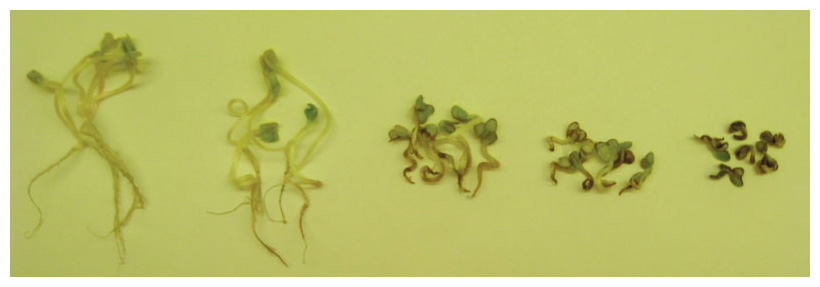DNA Damage and Nanoparticles
By Fenella Saunders
Q&A with Bryant C. Nelson, a research chemist, who is developing methods to quantify whether nanoparticles cause genetic damage.
Q&A with Bryant C. Nelson, a research chemist, who is developing methods to quantify whether nanoparticles cause genetic damage.

DOI: 10.1511/2016.119.70
There’s been a boom in products containing nanoparticles—bits of materials around 100 nanometers or less in diameter. On such small scales, familiar elements and compounds take on novel, often quite useful properties. But it’s unknown how many of these nanoparticles are leaking into the environment, or what harm they might do there; for instance, a few studies have shown that silver nanoparticles, used for their antibacterial qualities, can damage liver and brain cells. Regulations currently treat nano and bulk versions of materials exactly the same. Bryant C. Nelson (below), a research chemist at the National Institute of Standards and Technology (NIST) and a Sigma Xi Distinguished Lecturer, is developing methods to quantify whether nanoparticles cause genetic damage. He spoke about his research with managing editor Fenella Saunders. (A video of the full interview is available.)

Bryant C. Nelson
Is there a distinction between natural and engineered nano particles?
We call them engineered nanomaterials, but they actually have been around as natural nanomaterials since time immemorial. A good example is carbon nanotubes. They are prevalent in the environment and the initial forms of these materials come from volcanic eruptions or even from automobile exhaust, but we can also design these carbon nanotubes using chemical procedures.
Is the use of nanomaterials in consumer products just a fad?
It's definitely not a fad. There's a lot of commercial interest in their production. Engineered silver nanoparticles that may have antibacterial properties are in products from socks to washing machines. You can produce stronger materials out of certain nanomaterials, and there are some that may have medical applications.
As these products get more mainstream, are more nanoparticles released into the environment?
We want to know what type and how much of the nanomaterials are potentially entering the environment, but to do that, we have to have the methodology, measurements, and protocols in place to be able to actually measure the small quantities that are released and to identify the type of nanomaterials that are present. It becomes really complex in that there's not going to be just one type of nanoparticle released into the environment. There's going to be multiple different forms, so we need new methods and technologies to be able to discriminate between all these different types of materials. As we develop methods for detecting nanoparticles in different environmental matrices, whether it's water, sediment, or even the air, we have two main strategies: identification of the particles and quantification of the particles. The focus these days is really to be able to identify individual particles.
What happens when these nanoparticles interact with a cell?
We're looking at molecular level interactions. We're trying to understand, for example, how carbon nanotubes may change the properties of DNA.
DNA can repair itself, so how vulnerable is it to such damage?
Even when we're just walking around, our DNA is being damaged. For example, ultraviolet light can induce some damage to our DNA and therefore, the body has to have a mechanism to repairing that. Fortunately, humans and other living organisms have many redundant DNA repair systems in their bodies. Ionizing radiation may create free radicals such as hydroxyl, which can cause oxidation of DNA. If they're close enough to the DNA, free radicals can interact with the DNA in the cell liquids and cause these changes. The hydroxyl radical actually attaches to the DNA base molecule. The structure of a given base may either collapse or expand. Or it can cause the DNA to lose a base.
Change in the genetic code itself is possible from such damage as well?
When you induce these oxidatively modified bases, the sequence of your DNA is modified. If your cells replicate and those modified bases become set, then you have the increased chance of mutagenesis, and that could lead to cancer.
How can nanoparticles cause this kind of DNA damage?
There are several different mechanisms that have been identified. If they're small enough, they can enter the nuclear pore and get transported into the nucleus, where they could interact directly with DNA. There, the particles may be binding to the DNA, and that potentially causes all kinds of havoc.
One of the predominant mechanisms is through nanoparticles also producing free radicals. Some nanoparticles, if they're based on certain metals, can interact with the hydrogen peroxide that is present in every cell, and convert it to a hydroxyl radical, which can enter the nucleus and then you potentially have DNA damage.
How do nanoparticles get inside cells?
Some nanoparticles actually can enter cells through endocytosis, where they are engulfed by a vesicle in the cell membrane. If enough of them enter, they can increase the oxidative stress in the cell. At that point, the cell recruits different types of neutrophils or macrophages to the spot, and you get an enhanced production of free radicals, which can travel throughout the cell. That's actually a natural response to an exogenous particle entering a cell. But nanoparticles can exceed the natural antioxidant defense system of a cell. There's so much hydroxyl being produced that the cell can't handle the increased level and you get this oxidative burst that may overwhelm the cells.

How do you quantify this damage that happens to the DNA?
We remove the bases from the DNA chain using what's called a base excision repair protein. We take a known chemical that has been labeled with stable isotopes, and we incubate that with the modified base. Then we can take the ratio of the bases that are modified in the DNA sample and compare it to the amount of DNA that was added in. In the end, we come up with a mass of how much of each base is in that sample.
You use several different screening models in these tests?
We're using the most simple model up to the most complex. We start with the simple DNA by itself, then incubate it with nanoparticles, and try to measure the production of these DNA modifications to get a baseline for how nanoparticles may or may not interact with DNA. From there, we go on to cells. Finally, the ultimate goal is to develop methods where we can extract DNA from higher organisms such as plants and the nematode C. elegans.
What sample size do you need?
We really need a large amount of DNA, on the order of 50 micrograms. That’s roughly 5 million HeLa cells, or about 250,000 C. elegans. We're culturing billions of them in the laboratory, so we really don't have a shortage of DNA.
How many times do you repeat these tests to establish a standard?
Reproducibility really is key. We do every experiment in its entirety two or three times to be sure that what we measure is real. That's a big problem in science right now. When you see a response, whether it's positive or negative, you really need to do that study several times to verify its validity.
Have you found that specific conditions affect nanoparticle properties?
Titanium dioxide nanoparticles—used in paints, cosmetics, and various other products—has been shown in some studies to produce free radicals when exposed to light, whereas other studies have shown that it doesn't. We designed our study where we exposed plain DNA to titanium dioxide nanoparticles under different conditions of light: no light, regular lab light,and ultraviolet light. We found that titanium dioxide in the dark does not induce DNA damage. In visible light, it depends on how much titanium dioxide is present. With ultraviolet light you can see a higher level of DNA damage. The study showed basically that you have to use controlled measurement conditions to make an assessment of whether or not DNA damage is occurring.
Could nanoparticles also reduce DNA damage, or fight cancer?
Carbon nanotubes can scavenge free radicals in various types of cell environments. We wanted to develop a method to determine whether carbon nanotubes can also prevent or reduce oxidative DNA damage.
We took carbon nanotubes and wrapped them with single stranded DNA and exposed them to a defined amount of ultrasound, which is known to produce free radicals similar to ionizing radiation. We wanted to see whether the carbon nanotubes had an effect on scavenging the free radicals. We've shown that, yes indeed, you can reduce the level of DNA damage based upon the carbon nanotubes’ ability to scavange free radicals. But there's a lot that needs to happen before this research could be a viable therapy.
Could certain nanoparticles be used to target cancer cells?
We're working with really small gold nanoparticles, about 1.4 nanometers in diameter, and we're trying to develop a procedure to figure out whether these particles can inhibit DNA repair proteins. Thus far, they are showing some evidence that they can. If you could target those particles to a cancer cell, then you may have some groundwork to develop that as a modality for anti-cancer agents. There's many ways to expand upon the use of these nanoparticles, but there's a tremendous amount of work that needs to go into that development.
Will your research help guide policy on the safety of nanoparticles?
NIST doesn't get involved in policy making or policy induced decisions, just methodology. But I think that as long as we continue to develop robust methodology for highly sensitive, reproducible measurements that others can use to determine whether these nanoparticles are hazardous or helpful, then we're doing our mission. We're on track.
Click "American Scientist" to access home page
American Scientist Comments and Discussion
To discuss our articles or comment on them, please share them and tag American Scientist on social media platforms. Here are links to our profiles on Twitter, Facebook, and LinkedIn.
If we re-share your post, we will moderate comments/discussion following our comments policy.